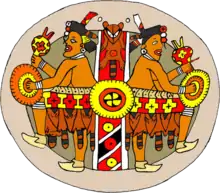Mount Albion complex
The Mount Albion complex was an early Archaic culture from about 4050 to 3050 BC, particularly distinguished by the Mount Albion side-notched projectile. It was called by James Gunnerson, the best known early Archaic culture in Colorado. It is related or similar to the Albion Boarding House phase.[1][2]
The Hungry Whistler Site and 5BL70 sites, on the slopes of Mount Albion in Boulder County, are the greatest sources of information about the Mount Albion complex. Hungry Whistler, a kill and butchering site, at 11,500 feet (3,500 m) is the type site for the Mount Albion complex. Hunters used a game drive system on the site to drive game between stone walls. The archaeological findings were dated over four periods from about 3850 to 3060 B.C.[2] Site 5BL70, located near Hungry Whistler at 11,368 feet (3,465 m), was used as a campsite and a place to gather wild plants. Stone tools were also made there. It was inhabited twice, once about 3700 B.C. and again about 3400 B.C.[3]
LoDaisKa Site, Magic Mountain, Mount Albion, Helmer Ranch in Douglas County, and Yarmony House in Eagle County, Colorado are examples of the Mount Albion complex.[3]
References
- Gibbon, Guy E., and Kenneth M. Ames. Archaeology of Prehistoric Native America: An Encyclopedia. New York: Taylor and Francis, 1998, xlvii/11/488. ISBN 0-8153-0725-X.
- Gunnerson, James H. Archaeology of the High Plains. Denver: United States Forest Service, 1987. p. 28.
- Gunnerson, James H. Archaeology of the High Plains. Denver: United States Forest Service, 1987. p. 28-29.

